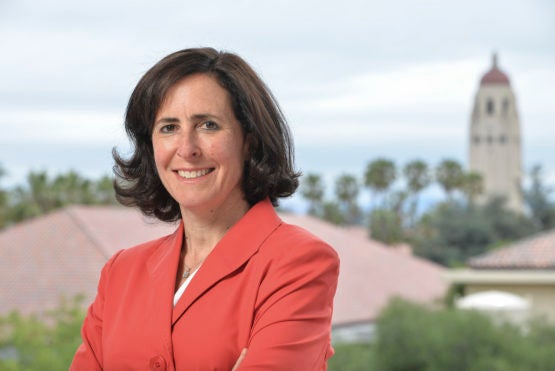Stacey Bent appointed Stanford vice provost for graduate education and postdoctoral affairs
Engineering Professor Stacey Bent has been named vice provost for graduate education and postdoctoral affairs. She will assume her new role on Sept. 1.
Stacey Bent, senior associate dean for faculty and academic affairs in Stanford’s School of Engineering, has been named the university’s vice provost for graduate education and postdoctoral affairs, Provost Persis Drell announced.

Stacey Bent will become the new vice provost for graduate education and postdoctoral affairs on Sept. 1. (Image credit: Rod Searcey)
Bent, who is the Jagdeep and Roshni Singh Professor in the School of Engineering, will begin her new role – which focuses on enhancing and enriching graduate education and the postdoctoral experience at Stanford – on Sept. 1.
Drell said she and Stanford President Marc Tessier-Lavigne are excited to have Bent join the Executive Cabinet and lead the university’s collaborative programs and advocacy on behalf of graduate students and postdoctoral scholars.
“Stacey brings the experience of a passionate researcher who has worked with graduate students and postdocs closely for decades,” Drell said. “She is eager to learn about the experiences and perspectives of graduate students and postdocs across the institution and to focus on what is needed to support their success and well-being.”
Bent succeeds Patricia Gumport, who launched the university-wide office of the Vice Provost for Graduate Education in January 2007. Gumport will return to teaching in Stanford’s Graduate School of Education and resume her work as director of the Stanford Institute for Higher Education Research.
“I am thrilled to have the opportunity to represent Stanford’s graduate student and postdoctoral community as the next vice provost for graduate education and postdoctoral affairs,” Bent said. “The office works collaboratively across the university to offer educational opportunities to our students, and I’m looking forward to helping them take steps to have a successful and fulfilling experience at Stanford that will prepare them to thrive in and contribute to a changing world.”
Working with individuals and serving on commissions, Bent has long been involved in identifying ways to advance graduate and undergraduate students’ educational experiences.
Bent has been a research adviser to about 50 doctoral candidates and 20 postdoctoral scholars, most of them since joining the Stanford faculty in 1998.
Fourteen years ago, she played a significant role in the creation of the office she will soon lead. She served on the Commission on Graduate Education that, in 2005, recommended creation of the vice provost position and office to address the complex issues stemming from the decentralized practices within the university’s seven schools.
She co-chaired the Academic Steering Group on Education for Stanford’s long-range planning effort in 2017–18 and served on the American Chemical Society’s Presidential Commission on Graduate Education in the Chemical Sciences in 2011–12. That panel’s charge included identifying steps to ensure that “graduate education addresses important societal issues, as well as the needs and aspirations of graduate students.”
Bent is a professor in the Department of Chemical Engineering and holds courtesy faculty positions in the Electrical Engineering, Materials Science and Engineering, and Chemistry departments. She is also director of the TomKat Center for Sustainable Energy and is a senior fellow in the Precourt Institute for Energy. Her research focuses on understanding surface and interfacial chemistry and materials synthesis, and applying this knowledge to a range of problems in sustainable energy, semiconductor processing and nanotechnology. Her group currently studies new materials and processes for electronics, solar cells and catalysis.
She holds an undergraduate degree in chemical engineering from the University of California, Berkeley, and a doctorate in chemistry from Stanford. After carrying out postdoctoral work at AT&T Bell Laboratories, she joined the chemistry faculty at New York University.
